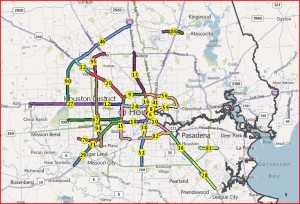From the On The Move blog:
Dallas motorists suffer the most highly congested road conditions in Texas, says a recent report from the Texas Department of Transportation.
The state’s top three bottlenecks are all located in Dallas County, according to the 100 Most Congested Roadway Segments in Texas. But while Dallas has the hottest spots, Harris County actually has more of them. The Houston area has 31 on the worst road conditions traffic list while Dallas has 21.
Road conditions for Fort Worth are next in line for headaches, with 15 tight spots, followed by San Antonio with 11 and Austin with 10.
Here are the top 10 most congested roads and their respective counties:
- SS 366 in Dallas, from I-35E to U.S. 75
- I-635 in Dallas, from I-35E to U.S. 75
- U.S. 75 in Dallas, from I-635 to Woodall Rodgers Freeway
- I-35 in Travis, from SH 71 to U.S. 183
- I-35W in Tarrant, from I-30 to SH 183
- U.S. 59 in Harris, from I-10 to SH 288
- I-35E in Dallas, from I-30 to SH 183
- I-10 in Harris, from I-45 to U.S. 59
- I-610 in Harris, from I-10 to I-45
- I-45 in Harris, from I-10 to I-610
See this interactive map to locate all 100.
Congestion patterns haven’t changed much over the past year, Texas officials say.
Here’s what struck me about this. Take a look at the map for Houston:
As was the case last year, by far the worst congestion is inside and on Loop 610, with the roads between 610 and Beltway 8 right behind. For all the billions we’ve spent on I-10, it still sucks, with the stretch from Beltway 8 to 59 being worse than the stretch outside Beltway 8. I-45 is a mess from one side of the Beltway to the other, but especially from 610 South and up. 59 is a parking lot from the West Loop to I-10. And none of that is getting any better.
I harp on this stuff because I get so worked up about how skewed our priorities are. We’re about to spend billions on a road to nowhere out of some vague concern about future traffic when we’ve got traffic stacked up to high heaven right now on existing roads. The reasons behind this are entirely political, yet the people who are affected by it essentially have no voice in the process. We engage in urban planning on a massive scale when it suits those who benefit from it and cry about distorting the “free market” when it doesn’t.
Of course, part of the problem is that the standard solution of simply pouring more concrete and increasing lane capacity won’t work in many of these areas. As I’ve discussed before, two big factors in the congestion on these roads are interchanges – I-10 to I-45, 59 to 610 and vice versa, 59 to 45, etc – and that all of these roads narrow to two lanes at some point inside the Loop, with no place to go to add any more. The only way we are going to be able to truly increase capacity for mobility inside the Loop is to add rail. Frankly, I don’t know that I’ll live long enough to see that happen. But for less than what we’ll be spending on a few miles of road through empty land in far northwest Harris County, we could more than double what the 2012 Metro Solutions plan will eventually provide, and in doing so add a lot of rail to the most heavily traveled parts of the city. If we did that, we just might get some people who currently use these congested freeways for local trips to stay away from them so that the people who have no viable alternative can get where they need to go. It’s a win for all involved, if only we’d recognize it as such. I won’t be holding my breath for it, I’m afraid.

